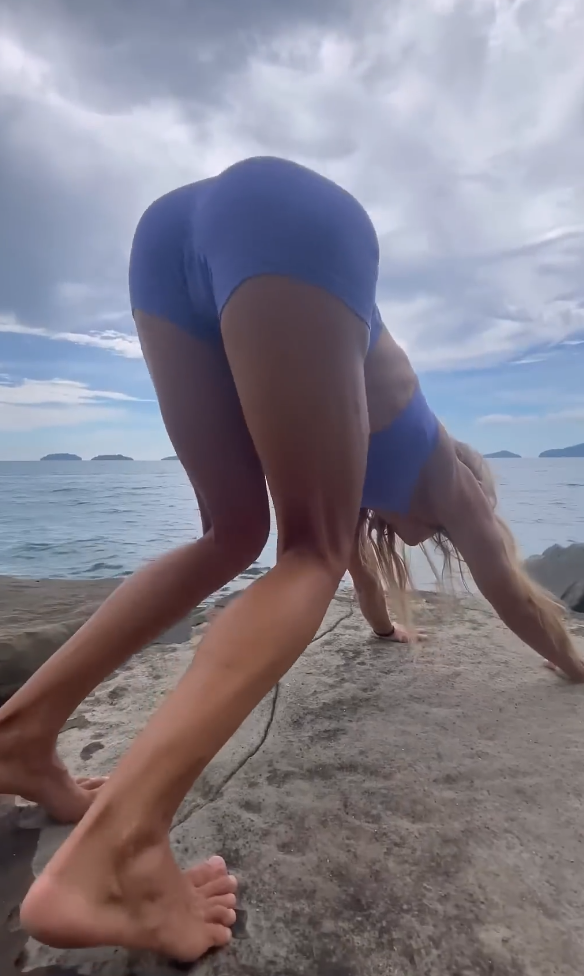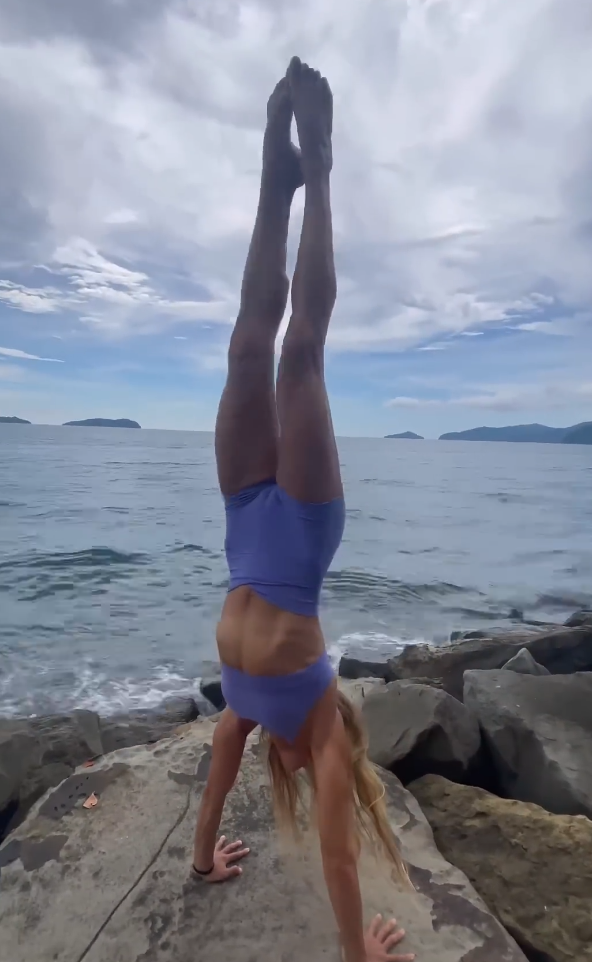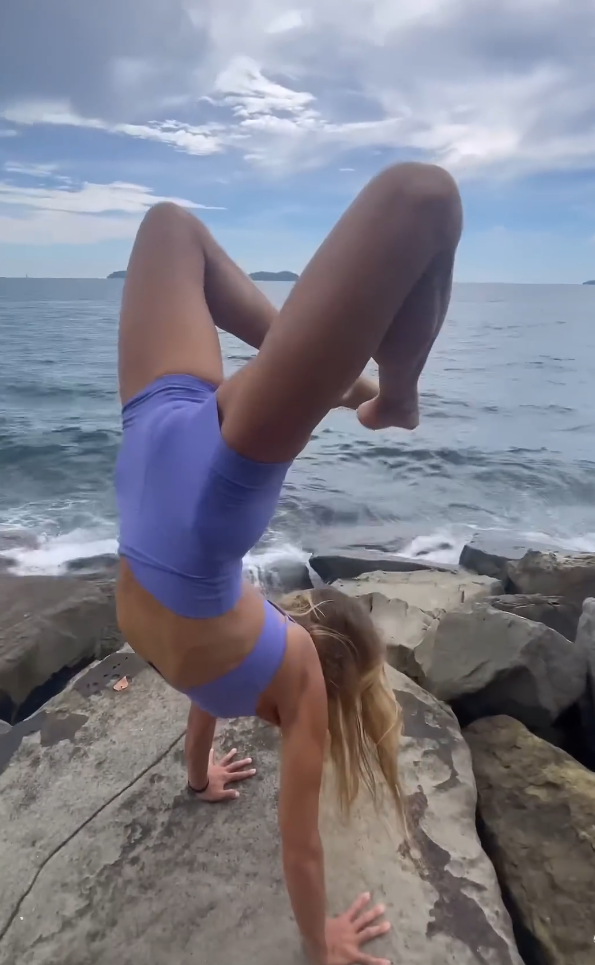There’s something undeniably magical about doing yoga outdoors — the fresh air, the natural soundtrack, and the raw textures of the earth beneath you. But take that experience to the next level by flipping your world upside down, quite literally, with inversions on the rocks.
Whether you’re a seasoned yogi or just starting your fitness journey, practicing inversions — like headstands, handstands, and forearm balances — on natural surfaces adds a new dimension to both your body awareness and your mindset. It’s not just yoga anymore. It becomes a full-body adventure, a mental reset, and an act of courage all rolled into one.

Why Inversions?
Inversions are the crown jewels of yoga. They reverse your perspective, increase blood flow to the brain, and challenge your strength, balance, and focus. From a fitness standpoint, inversions build upper body power, engage your core, and test your proprioception (the awareness of your body in space). Psychologically, they teach patience and help overcome fear. Energetically, many practitioners say inversions feel like a shot of espresso — stimulating, refreshing, and elevating.
Now imagine bringing all those benefits outdoors — specifically, to the rocks.

Nature: The Ultimate Yoga Studio
Practicing inversions on rocky terrain might sound a bit intimidating at first, but it’s also thrilling. The uneven surface forces you to be fully present. Your hands feel the grains of stone, your muscles engage to stabilize, and your senses awaken with the crisp breeze, the scent of earth, and the distant sound of birds or waves.
There’s no ceiling above you — only sky. No mirrors — only self-reflection. It’s yoga stripped down to its essence: breath, body, and connection to the natural world.

Getting Started: Safety First
Before attempting inversions on rocks, safety is key. Here are some important tips to keep in mind:
- Find a safe location: Look for flat, stable rocks with enough space around you. Avoid slippery or sharp surfaces.
- Use a mat or towel: Even though you’re on rock, a thin yoga mat or towel can protect your hands and head from scrapes and add a bit of comfort.
- Warm up thoroughly: Always prepare your shoulders, wrists, and core with dynamic stretches and strength-building poses like Downward Dog, Dolphin Pose, and Plank.
- Start low: If you’re new to inversions, start with legs-up-the-rock (like Legs Up the Wall Pose), or a supported headstand near a boulder to catch you if needed.
- Bring a buddy: Having a friend spot you can boost your confidence and reduce the risk of injury.

Inversions to Try on the Rocks
Here are a few inversion poses that are suitable (and stunning) on rocky terrain:
1. Downward Facing Dog (Adho Mukha Svanasana)
Okay, it’s not a full inversion, but it’s a great way to start. Your head is below your heart, and it preps the body for deeper inversions. Let your heels press into the rock, feel the stretch through your spine, and breathe deeply.
2. Dolphin Pose
This forearm-based posture strengthens the shoulders and gets you inversion-ready. On rocks, it challenges your balance and alignment even more, making it the perfect bridge between grounding and flying.

3. Headstand (Sirsasana)
Often called the king of yoga poses, a headstand demands focus and control. On rocks, make sure to place your head and forearms securely. Engage your core, press through the forearms, and rise slowly, one leg at a time. It’s powerful, peaceful, and incredibly photogenic.
4. Forearm Stand (Pincha Mayurasana)
This advanced pose requires shoulder strength and core control. The uneven surface adds a new level of challenge — but also sharpens your awareness. Keep the body tight, gaze forward, and find your stillness.
5. Handstand (Adho Mukha Vrksasana)
The ultimate inversion! A handstand on the rocks is not for the faint of heart, but when you get it — even just for a second — you’ll feel like you’ve conquered the mountain. Literally and metaphorically.
The Emotional Benefits of Going Upside Down Outdoors
Doing inversions outside, especially in raw environments like cliffs, canyons, or coastal rocks, is not just a physical experience — it’s an emotional one. You feel bold. You feel alive. The fear of falling, the strength to rise, and the quiet that settles once you’re steady — it’s a lesson in trust and empowerment.
Yoga on rocks is a great teacher. It teaches you that stability isn’t about perfect conditions — it’s about how you show up in your body. And inversions remind us that sometimes, the best view comes when you flip your perspective.
How to Build Toward It
If you’re not quite ready to kick up on a rocky ledge, that’s okay. Here’s how to train for it:
- Practice indoors first: Master your inversion poses on flat, secure surfaces before moving them outdoors.
- Strengthen your foundation: Work on shoulder presses, planks, and hollow-body holds to build control.
- Work on your mindset: Visualize success. Use affirmations like “I am strong, balanced, and grounded.”
- Breathe through fear: Fear is natural, but breathing calms the nervous system. Inhale courage, exhale doubt.
Yoga Fitness That Transcends the Studio
Modern yoga fitness isn’t confined to the studio walls or sleek wooden floors. It thrives wherever you bring your body and breath into union — especially in wild, rugged, real-life spaces. By combining the discipline of yoga with the raw beauty of rocky landscapes, you’re not just doing a workout. You’re having an experience.
It’s meditation in motion. Strength in softness. Adventure in stillness.
So next time you’re near a rocky coastline, a mountain trail, or even just a neighborhood stone wall, take a moment. Place your hands on the stone. Feel the ground. Breathe. And if it feels right — go upside down.
Final Thoughts
Inversions on the rocks are not about perfection. They’re about presence. It’s not about how long you can hold a handstand or whether your legs are perfectly straight. It’s about showing up. About being brave enough to fall, and strong enough to rise again.
Yoga fitness is more than flexibility and toned arms. It’s a lifestyle of awareness, exploration, and connection. So go ahead — roll out your mat, find your rock, and let gravity become your playground. Your body will get stronger, your heart braver, and your spirit a little more wild and free.
💕 Breathe deep. Flip the script. Live upside down. 💕
Would you like this turned into a blog post or social media carousel too?
Have you ever felt the wind brush against your skin as you held a handstand above a breathtaking cliff, with the ocean crashing below you? That feeling of being upside down — heart racing, world spinning — but somehow completely centered? Welcome to Inversions on the Rocks, where yoga fitness meets wild adventure and soulful freedom.
This is not your average yoga class. It’s a celebration of strength, balance, courage, and connection — all set against nature’s most awe-inspiring backdrops. Whether you’re a seasoned yogi or just curious about flipping your world upside down, there’s something magical about taking your practice outside, especially when you add rocks, sky, and a dash of daring.
Why Inversions?
Inversions in yoga — poses where your heart is higher than your head — are known for their energizing, empowering effects. Think headstands, handstands, forearm stands, and shoulder stands. These poses challenge your body and your mind, forcing you to focus, engage your core, breathe deeply, and trust yourself.
But inversions aren’t just flashy moves for Instagram (although, yes, they do look epic on the edge of a cliff). They have powerful physical and mental benefits:
- Improved circulation and blood flow to the brain
- Strengthened core, arms, and shoulders
- Enhanced balance and proprioception
- Boosted confidence and reduced fear
- Stress relief and a fresh perspective
Inversions are a metaphor for life. They teach us to face fear, turn things upside down, and stay calm when the world feels reversed. When you can find stillness in an inversion, you can find it anywhere.
Nature as the Ultimate Studio
Practicing yoga on the rocks adds a whole new layer of connection. The uneven surfaces, the wind, the raw earth beneath your fingers — it’s grounding and exhilarating at once. The rock becomes your mat, your teacher, and your test.
Why do yogis love practicing outdoors?
- Natural Resistance: The terrain adds challenge and depth to your poses.
- Mental Reset: The beauty around you helps clear your mind and center your breath.
- Connection to Earth: Yoga means union, and there’s no better way to feel united with the planet than standing on it, upside down.
- No Mirrors, No Pressure: Just you, your breath, and the open sky.
Whether you’re on a mountain ledge, a desert plateau, or by the sea, nature invites you to let go of perfection and embrace the present moment.
Getting Started: The Basics of Inversion Training
Before heading to the rocks, you’ll want to build a solid foundation indoors. Safety first — your body needs time to develop strength, mobility, and control.
Here’s how to start:
1. Warm-Up Is Key
Prepare your wrists, shoulders, and spine. Sun Salutations, Dolphin Pose, and Cat-Cow sequences help open and activate your body.
2. Strengthen Your Core
Try Plank, Boat Pose, and Leg Lifts. A strong core is essential for stability in any inversion.
3. Wall Work
Use a wall to safely practice Headstand and Handstand entries. Focus on alignment and breath control.
4. Dolphin to Pincha
Dolphin Pose builds shoulder strength and is a great prep for Forearm Stand (Pincha Mayurasana).
5. Fear Management
Falling is part of the journey. Practice safe exits and build confidence gradually. Use props like blocks and cushions during practice.
Bringing It to the Rocks 🪨
Once you feel stable, it’s time to take it outside. Choose a safe, dry surface with good traction. Avoid slippery or unstable rocks. Flat boulders, beachside formations, and large granite slabs are popular among yoga adventurers.
Tips for Safe Rock Yoga Inversions:
- Check the surface: Look for cracks, moss, or loose gravel that could throw off your balance.
- Wear grippy yoga gear: Barefoot is often best for traction.
- Use a spotter: Especially for handstands or more advanced poses.
- Practice at sunrise or sunset: Cooler temperatures, softer light, and often fewer people.
- Know your limits: If it feels risky, modify or skip it. The goal is presence, not perfection.
The Emotional High
There’s a unique sense of power that comes from balancing upside down on a cliff, or breathing deeply in a forearm stand with waves crashing around you. It’s not about showing off — it’s about showing up for yourself.
“Inversions on the rocks” is more than a workout. It’s a moving meditation, an invitation to challenge your perspective, and a love letter to your inner strength.
When you go upside down, something shifts. You see the world differently. You feel your heart beat louder. You laugh at your own wobble. And when you finally find stillness — even for just one breath — it’s pure magic.
Inspiration from the Wild
Some of the world’s most inspiring yoga photographers and athletes have embraced this rugged approach. Just look up accounts like @yogawithnature or @wanderingyogi and you’ll see yogis balancing in the Dolomites, flipping in the desert, and folding into crow pose on sunlit canyon walls.
You don’t need to be a social media star to experience this, though. You just need your body, your breath, and the courage to try.
Yoga Meets Adventure Fitness
“Inversions on the Rocks 💕” is also a fitness philosophy. It combines yoga’s breath and mindfulness with the athleticism of climbing, hiking, and bodyweight training.
It’s for the curious ones — the bold souls who want to feel alive in their skin, who thrive on movement, sweat, and spiritual connection.
The combo of yoga and nature creates a full-body, full-spirit experience. You’re not just working muscles — you’re working trust, patience, and self-love.
Final Thoughts
So maybe the next time you head out for a hike, you pause at the summit, roll out your mat (or just go barefoot), and kick up into a handstand against the wind. Or maybe you just sit in stillness, legs in the air, heart open to the sky.
Yoga isn’t about being flexible or strong — it’s about awareness. Inversions on the rocks push you to be aware in the most primal, beautiful way.
💕 This is your invitation: Flip the script. Take the leap. Let nature catch you. Let the rocks ground you. Let the sky hold your feet. And let your heart soar.
Namaste, upside down. 🙃
Let me know if you’d like to pair this with photos, a yoga sequence, or a fitness schedule!



